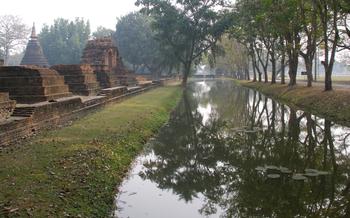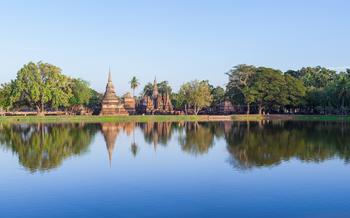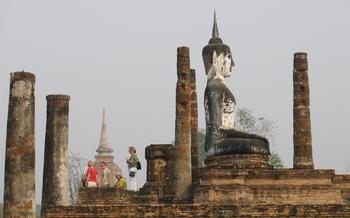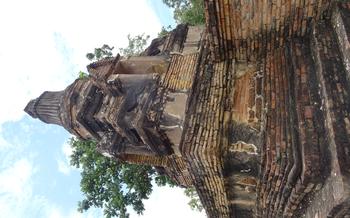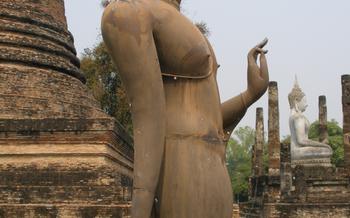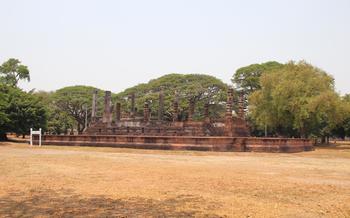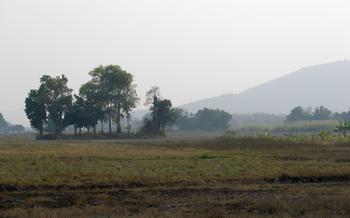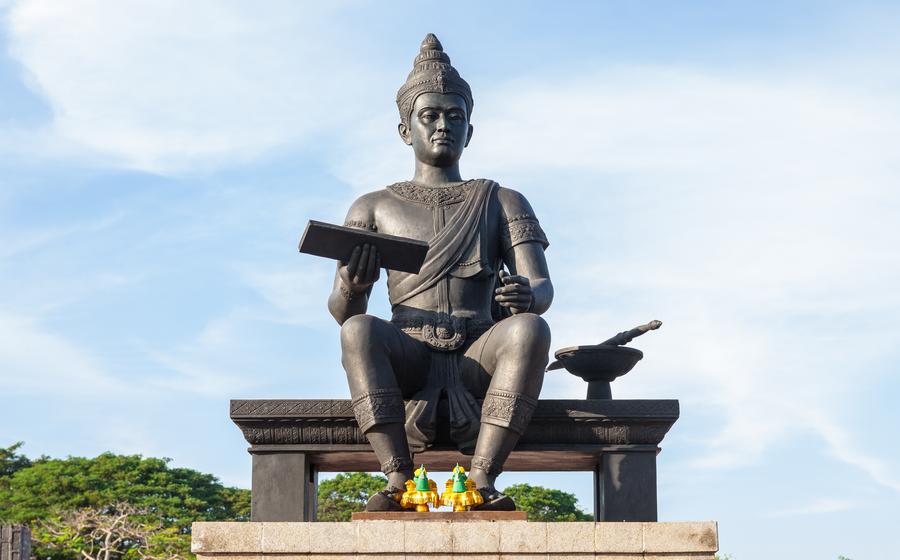
King Ramkhamhaeng Monument
- King Ramkhamhaeng Monument: A Symbol of Sukhothai's Glorious Past
- Location and Accessibility
- Physical Description
- Historical Significance
- Cultural and Religious Bedeutung
- Visitor Facilities and Services
- Photography and Videography
- Accommodation Options
- Budget and Cost
- Responsible Tourism
- Events and Festivals: A Journey Through Thai Cultural Heritage
- Insider Tip: Uncover the Hidden Gem of Wat Mahathat
King Ramkhamhaeng Monument: A Symbol of Sukhothai's Glorious Past
The King Ramkhamhaeng Monument stands as a testament to the glorious past of Sukhothai, a kingdom that flourished in the 13th and 14th centuries. Erected in 1963 to commemorate the 700th anniversary of King Ramkhamhaeng's reign, the monument is a symbol of the king's legacy and the kingdom's rich history.
The monument's design reflects the architectural style of the Sukhothai era, with its distinctive lotus-shaped base and slender spire reaching towards the sky. The monument is adorned with intricate carvings, inscriptions, and symbolic elements that convey the cultural and religious significance of the Sukhothai period.
King Ramkhamhaeng, the third ruler of the Sukhothai Kingdom, is credited with establishing the first independent Thai kingdom and introducing the Thai script. His reign marked a golden age of art, culture, and prosperity for Sukhothai, and his legacy continues to inspire Thais today.
The monument's location within Sukhothai Historical Park, a UNESCO World Heritage Site, adds to its historical significance. The park is home to numerous ancient ruins, temples, and monuments, providing a glimpse into the grandeur of the Sukhothai Kingdom. The King Ramkhamhaeng Monument stands as a symbol of this rich heritage, inviting visitors to explore the fascinating history and culture of Thailand's past.
Location and Accessibility
The King Ramkhamhaeng Monument stands majestically within the sprawling grounds of Sukhothai Historical Park, a UNESCO World Heritage Site. Visitors can easily reach the monument by following the well-marked paths and signs from the park's main entrance. The monument is situated in the heart of the park, surrounded by other historical ruins and temples, making it a convenient stop on a comprehensive tour of the site.
For those arriving by public transportation, local buses and tuk-tuks provide convenient access to the historical park. Guided tours are also available, offering a hassle-free way to explore the park's highlights, including the King Ramkhamhaeng Monument. Alternatively, visitors can opt for a self-guided exploration, allowing them to set their own pace and delve deeper into the monument's history and significance.
The best time to visit the King Ramkhamhaeng Monument is during the cooler months, from November to February, when the weather is pleasant and the crowds are smaller. However, the monument's beauty can be appreciated year-round, as the changing seasons bring different visual delights.
To make the most of a visit, consider combining the monument with other attractions within the historical park. The nearby Wat Mahathat, with its iconic prang, and the Sri Satchanalai Historical Park, located just north of Sukhothai, offer additional historical and cultural treasures to explore.
Physical Description
The King Ramkhamhaeng Monument stands tall and majestic, captivating visitors with its imposing size and grandeur. The monument's architectural design reflects the quintessential style of the Sukhothai era, characterized by its simplicity, elegance, and harmony with nature.
Its towering structure features a massive bronze statue of King Ramkhamhaeng, the revered founder of the Sukhothai Kingdom. The bronze casting captures the king's regal bearing and determination, as he stands with his hands clasped in a gesture of respect and authority. His regal attire and intricate headdress symbolize his power and prestige.
The base of the monument is adorned with exquisite carvings and bas-reliefs depicting scenes from the life of King Ramkhamhaeng and the history of the Sukhothai Kingdom. These intricate carvings showcase the remarkable craftsmanship of Sukhothai artisans, who skillfully expressed their artistic vision through stone.
The monument's overall design is a testament to the architectural prowess of the Sukhothai era. Its harmonious proportions, intricate carvings, and majestic presence create a lasting impression on visitors, leaving them in awe of the artistry and grandeur of this iconic landmark.
Historical Significance
The King Ramkhamhaeng Monument stands as a testament to the reign of King Ramkhamhaeng, a pivotal figure in Thai history who ruled the Sukhothai Kingdom from 1279 to 129During his reign, King Ramkhamhaeng oversaw a period of significant growth and prosperity for the kingdom, establishing it as a major power in the region.
The monument's construction in 1965 served to commemorate King Ramkhamhaeng's achievements and preserve his legacy. It represents the deep respect and admiration that the Thai people hold for this revered monarch. The monument's design incorporates symbolic elements that reflect King Ramkhamhaeng's reign and the values he espoused, such as justice, compassion, and strength.
The Sukhothai period, under King Ramkhamhaeng's leadership, marked a golden age in Thai history. It was a time of great artistic and cultural flourishing, as evidenced by the exquisite architecture, sculptures, and artifacts found in Sukhothai Historical Park. The kingdom's independence and sovereignty were fiercely protected during this era, and King Ramkhamhaeng's diplomatic skills and military prowess played a crucial role in maintaining peace and stability in the region.
The King Ramkhamhaeng Monument's recognition as a UNESCO World Heritage Site further underscores its global historical importance. This designation acknowledges the monument's outstanding cultural and historical value, as well as its contribution to our understanding of Thai history and civilization.
Cultural and Religious Bedeutung
The King Ramkhamhaeng Monument stands as a testament to Thailand's deep-rooted Buddhist traditions and beliefs. Its intricate carvings and inscriptions convey religious messages and teachings, inviting visitors to delve into the spiritual essence of the Sukhothai Kingdom. The monument's design and symbolism reflect Buddhist cosmology, with the lotus-shaped base representing the purity and enlightenment of the Buddha's teachings.
The monument's central feature is a large bronze statue of King Ramkhamhaeng, depicted in a seated meditation pose, exuding an aura of serenity and contemplation. The statue's hands are positioned in the mudra of meditation, symbolizing the Buddha's teachings of mindfulness and inner peace.
Inscriptions on the monument's pedestal recount the history of the Sukhothai Kingdom and King Ramkhamhaeng's reign, emphasizing his devotion to Buddhism and his role as a patron of the faith. These inscriptions provide valuable insights into the religious beliefs and practices of the Sukhothai period.
The King Ramkhamhaeng Monument is a significant pilgrimage site for Buddhists from Thailand and around the world. Devotees come to pay homage to the Buddha and seek blessings from King Ramkhamhaeng, who is revered as a symbol of wisdom, compassion, and righteousness.
Throughout the year, the monument hosts cultural events and ceremonies that showcase traditional Thai customs and rituals. These events provide visitors with an opportunity to immerse themselves in the vibrant religious and cultural heritage of Sukhothai.
Visitor Facilities and Services
The King Ramkhamhaeng Monument offers a range of amenities and services to enhance visitor experience. Restrooms are conveniently located near the monument, providing basic sanitation facilities for travelers. Seating areas are thoughtfully placed around the monument, allowing visitors to take a break, relax, and soak in the tranquil ambiance of the historical site. These seating areas provide a respite from the exploration and offer a chance to contemplate the monument's significance and grandeur.
For those seeking deeper insights into the history and cultural significance of the monument, guided tours are available. Knowledgeable and passionate guides lead these tours, sharing captivating stories and anecdotes that bring the monument to life. Visitors can learn about the monument's construction, its connection to King Ramkhamhaeng's reign, and the symbolism embedded in its design. The tours offer a comprehensive understanding of the monument's importance, allowing visitors to appreciate its historical and cultural value.
The monument is committed to accessibility, ensuring that visitors with disabilities have an inclusive and enjoyable experience. Wheelchair ramps and accessible pathways make it possible for individuals with mobility challenges to navigate the site with ease. Designated parking spaces for disabled visitors are also available, providing convenience and ease of access. By prioritizing accessibility, the monument strives to welcome and accommodate all visitors, fostering an inclusive environment that celebrates diversity and inclusivity.
To preserve and promote local heritage, the monument offers a selection of souvenirs and local handicrafts for purchase. These items, crafted by skilled artisans, showcase the vibrant cultural traditions of Sukhothai. From intricate carvings to colorful textiles, the souvenirs serve as a tangible reminder of the visit and support the local economy. By purchasing these handcrafted items, visitors contribute to the preservation of traditional arts and crafts, ensuring their continued existence for future generations.
Photography and Videography
Capture the grandeur of the King Ramkhamhaeng Monument through stunning photographs and videos. Arrive early in the morning or late afternoon to take advantage of the soft, golden light that illuminates the monument, creating a magical atmosphere. Experiment with different angles and perspectives to showcase the monument's intricate details and imposing size. Use a tripod for stability and to achieve sharp, blur-free shots. For videographers, consider using a drone to capture aerial footage of the monument and the surrounding historical park, providing a unique and breathtaking perspective. Remember to respect the monument's cultural and religious significance by refraining from using flash photography or disturbing other visitors. Share your captured memories on social media, inspiring others to explore this historical treasure.
Accommodation Options
When planning a visit to the King Ramkhamhaeng Monument, a range of accommodation options are available to suit different preferences and budgets. For a truly immersive experience, consider staying in a traditional Thai-style guesthouse or homestay. These charming accommodations often offer a glimpse into local life and culture, with warm hospitality and delicious home-cooked meals.
For those seeking a more modern and comfortable stay, there are several hotels and resorts located near the historical park. These establishments offer amenities such as air conditioning, private bathrooms, and swimming pools, ensuring a relaxing and enjoyable stay.
To find the best accommodation deals, it's recommended to book in advance, especially during peak tourist seasons. Online booking platforms and travel agents can provide a wide selection of options and help secure the most competitive rates.
Here are some tips for choosing accommodation in Sukhothai:
-
Location: Consider the proximity of the accommodation to the King Ramkhamhaeng Monument and other attractions in the historical park. Staying within walking distance can save time and transportation costs.
-
Amenities: Decide which amenities are important to you, such as air conditioning, Wi-Fi, or a swimming pool. Prioritize the features that will enhance your comfort and enjoyment during your stay.
-
Budget: Set a budget for accommodation that fits your travel style and financial constraints. There are options available for budget travelers, mid-range travelers, and luxury travelers alike.
-
Reviews: Read reviews from previous guests to get an idea of the quality of the accommodation, the level of service, and any potential drawbacks. This can help you make an informed decision and avoid any unpleasant surprises.
Budget and Cost
Visiting the King Ramkhamhaeng Monument is relatively affordable, with entrance fees typically ranging from 100 to 200 baht for foreign visitors. Transportation costs depend on the chosen mode of transport, but public options like buses and tuk-tuks are budget-friendly. Food and accommodation expenses can vary depending on personal preferences and budget constraints. To save money, consider exploring local markets for authentic and affordable meals, and opt for guesthouses or homestays over luxury hotels. Guided tours can provide valuable insights but come at an additional cost. Budgeting around 1,000 to 1,500 baht per day should cover most expenses, excluding souvenirs and optional activities. Remember to exchange currency before your trip and be aware of the local payment options, as some smaller establishments may not accept credit cards.
Responsible Tourism
As a traveler, it's essential to embrace responsible tourism practices to minimize your environmental impact and support local communities. When visiting the King Ramkhamhaeng Monument and Sukhothai Historical Park, here's how you can contribute to sustainable tourism:
-
Reduce Waste: Avoid single-use plastics by bringing your reusable water bottle and shopping bags. Dispose of waste properly in designated bins to prevent littering and pollution.
-
Conserve Water: Water is a precious resource, especially in Thailand. Practice water conservation by taking shorter showers, reusing towels, and reporting any water leaks to park authorities.
-
Support Sustainable Businesses: Choose accommodations, restaurants, and tour operators committed to sustainability. Look for businesses that use eco-friendly practices, support local suppliers, and give back to the community.
-
Respect Local Customs: Thailand is a country with rich cultural traditions. Respect local customs by dressing appropriately, avoiding offensive language or gestures, and asking permission before taking photos of people or religious sites.
-
Give Back to the Community: Consider volunteering your time or donating to local organizations working to preserve Sukhothai's cultural heritage or support community development projects.
Events and Festivals: A Journey Through Thai Cultural Heritage
The King Ramkhamhaeng Monument and Sukhothai Historical Park come alive during various festivals and events throughout the year, offering visitors a unique opportunity to immerse themselves in Thai culture and traditions. The most prominent event is the Sukhothai Historical Park Loi Krathong Festival, held annually in November. During this festival, locals and tourists alike gather to release beautifully decorated krathongs (floating baskets) into the moat surrounding the monument. The festival symbolizes the release of worries and bad luck, and the sight of hundreds of illuminated krathongs floating on the water creates a magical and enchanting atmosphere.
Another significant event is the Sukhothai Historical Park Makha Bucha Day, celebrated in February or March. This Buddhist holiday commemorates the day when Buddha gave his first sermon to his disciples, and it is marked by candlelit processions, chanting, and meditation sessions at the monument. Visitors can participate in these ceremonies and gain a deeper understanding of Thai Buddhist traditions.
To experience the vibrant local culture, visitors can attend the Sukhothai Historical Park Folk Music and Dance Festival, held annually in January. This festival showcases traditional Thai music and dance performances, as well as local crafts and culinary delights. Visitors can enjoy live music, dance competitions, and workshops, providing a glimpse into the artistic heritage of Sukhothai.
These events and festivals offer a fantastic opportunity to witness Thai culture in all its glory and create lasting memories. Visitors are encouraged to participate in these events with respect and curiosity, immersing themselves in the local traditions and celebrations.
Insider Tip: Uncover the Hidden Gem of Wat Mahathat
Beyond the grandeur of the King Ramkhamhaeng Monument, Sukhothai Historical Park holds another hidden gem waiting to be discovered – Wat Mahathat. This ancient temple complex, nestled amidst serene surroundings, boasts a unique charm and historical significance that often goes unnoticed by tourists.
Take a leisurely stroll through the temple grounds and marvel at the intricate carvings adorning the stupas and Buddha images. The main stupa, standing tall and majestic, is a testament to the architectural prowess of the Sukhothai era. As you explore further, you'll uncover hidden corners, secluded Buddha statues, and ancient inscriptions that reveal the rich history of this sacred site.
For a truly immersive experience, visit Wat Mahathat during the annual Loi Krathong festival. The temple comes alive with vibrant colors and cheerful locals as they release their beautifully crafted krathongs (floating lanterns) into the surrounding moat. It's a magical moment that captures the essence of Thai culture and tradition.
Whether you're a history buff, a nature enthusiast, or simply seeking tranquility, Wat Mahathat offers a unique and unforgettable experience. So, step off the beaten path and discover the hidden wonders of this remarkable temple complex.
